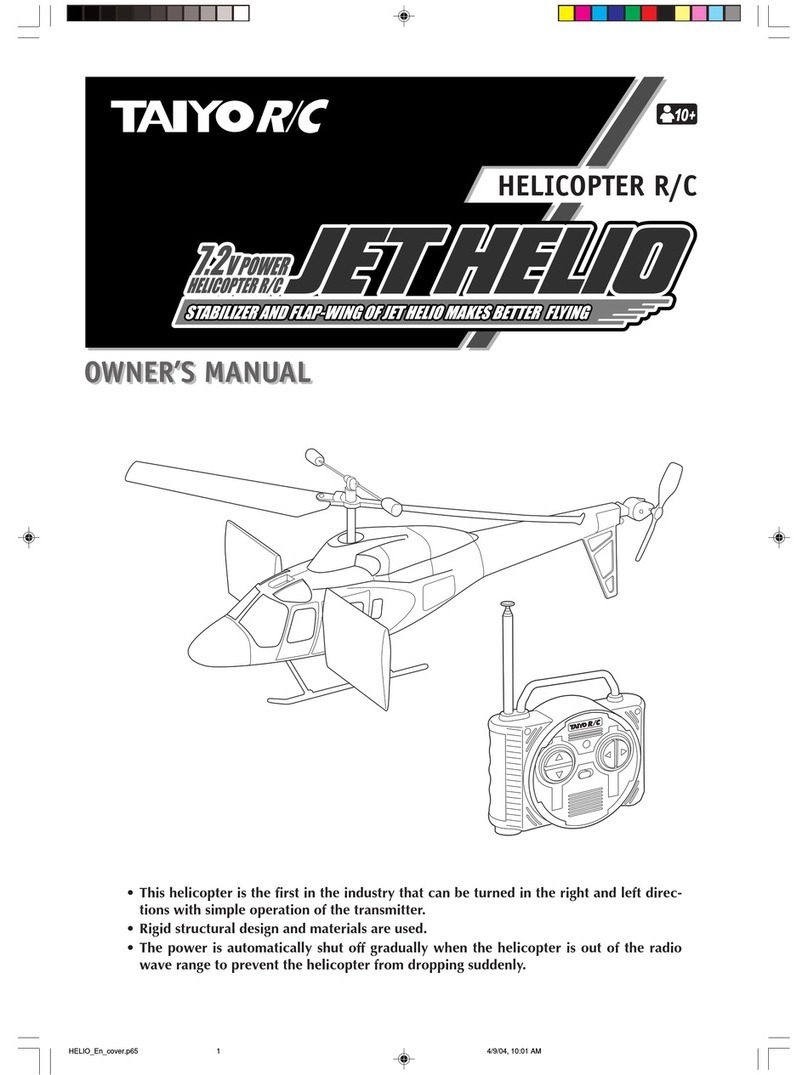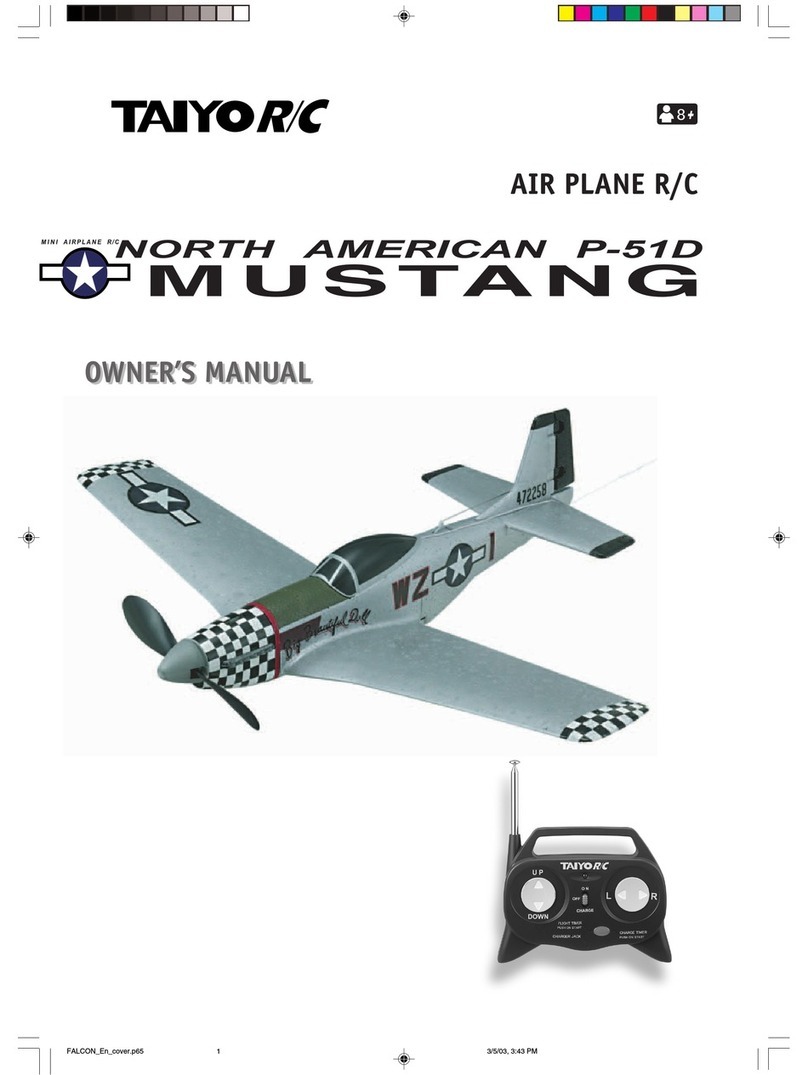ENG
7
Please check the headings I - VI with the
diagrams in pages 2, 3, 4, 5.
I. CONTENTS & FEATURES
This kit includes:
A. Micro Master x 1
B. Transmitter x 1
C. Charger x 1
D. Transmitter antenna x 1
E. Manual x 1
The product shown in the figure may slightly
differ from the real ones.
qMicro Master
qRotor
* The rotor has a play structure for safety,
but not completely fixed. When the rotor
starts rotating, the centrifugal force acts
on the rotor allowing it to operate normally.
wTail fin
eAntenna
* Do not cut the antenna rods.
rCharging port / Power switch (at the
bottom)
t3.7V LiPoly battery embedded
ySkid
uBody
iSafety ring
wTransmitter
Front
qAntenna
wThrottle Stick
eAdjustment Knob
rSwitch
tRudder stick (left/right) / Forward stick (for-
ward)
Rear
yBattery Cover
II. Installation
qTransmitter Antenna Installation /
Uninstallation
qAntenna Installation
Turn the antenna clockwise to screw it in
the transmitter body.
The antenna is screw-in type. Securely
screw it in place, otherwise a malfunction
may result from loose antenna
connection.
wAntenna Uninstallation
Turn the antenna counterclockwise to
remove it. When housing the antenna,
retract it from the root rib for avoiding
bending of the antenna rod.
wTransmitter Battery Installation
Use one 9-Volt (006P) battery for the trans-
mitter (not included).
qSlide open the BATTERY DOOR in the
direction shown in the figure.
wInsert the BATTERY with correct polarity
(+/-).
Insert a 9V (006P) BATTERY with the
polarity (+/-) as shown above.
eReplace battery door, following the
removal procedure in reverse.
* When the capacity of the 9V battery
becomes low, Power LED lamp changes
from steady to blinking. You need to
replace the 9V battery, otherwise a
malfunction may occur due to shortened
operating distance.
III.
Built-in Battery Charging Instructions
A rechargeable battery is built into the
helicopter body. Be sure to charge the battery
before you use it. The built-in LiPoly battery,
if not handled properly, may explode, cause
burns or catch fire resulting in a serious
accident.
Read "Handling of Lithium Polymer Battery"
and handle the battery properly.
qSet the power switch of the helicopter to
"OFF", insert the charger connector to
the charging port on the helicopter then
plug the charger to a standard wall
outlet.
The LED lamp will light in red.
* The LED lamp lights in green if the
charger is plugged to a wall outlet while
the charger connector is not inserted to
the helicopter.
q-1 Charging port.
wRed lamp on charger will light to show
charger is operating.
w-1 Charging port.
eWhen charge is complete, the LED lamp
changes to green. Remove the charger
connector from the charging port on the
helicopter then unplug the charger from
the wall outlet.
* Battery charging time varies with battery
level. As a guide, it takes approx. 1
hour when the battery is near empty, or
30 minutes if half-empty.
Important:
• To prevent overcharge of batteries,
observe the following instructions:
Do not re-peak a LiPoly battery that has
peaked. The battery, if not used to fly the
helicopter, does not require recharging in
the first one or 2 hours after a charge.
IV. How to Fly
qPreparation for flight
qTurn on the switch on the helicopter body,
then the LED lamp starts blinking.
When the LED lamp changes to steady,
the helicopter becomes ready for flight.
q-1 LED lamp.
wCompletely extend the transmitter antenna.
eTurn on the switch on the transmitter. Then,
the LED lamp starts blinking.
e-1 LED lamp (blinking)
rMove the throttle stick to the top position
then to the bottom. The transmitter
gets ready when the LED lamp changes
from blinking to steady.
r-1 LED lamp (steadily lighting)
tStay at least 2m away from the helicopter
before flying it up.
yCheck safety of environment around you.
Now you are ready if no obstacles exist.
wTransmitter Functions
qThrottle stick (right)(UP/DOWN)
Moving the throttle stick up allows the
helicopter to ascend, and moving the stick
back makes the helicopter descend.
q-1 Up
q-2 Down
wRudder stick (left)(Left / Right)
Moving the rudder stick left allows the
helicopter to turn left, and moving the stick
right makes the helicopter turn right.
w-1 Left turn
w-2 Right turn
eForward stick (left)(Forward)
Moving the forward stick up allows the
helicopter to fly forward.
eGet skilled with the helicopter
qSlowly move the throttle stick up, then the
rotor starts rotating and the helicopter as-
cends. Since the ascending power varies
in synchronization with the stick operation,
adjust the throttle stick (right) to make the
helicopter hover when it reaches a height
of approx. 2m.
q-1 Up
q-2 Down
• If the helicopter tends to turn to one side,
turn the adjustment knob on the trans-
mitter to correct it.
q-3 Adjustment knob
wTo move the helicopter down, move the
throttle stick (right) back more slowly =than
when moving the helicopter up. When the
helicopter starts descending, hold the stick
in its position. The helicopter will land
gently by itself.
eWhile the helicopter is hovering, moving
the forward stick (left) up allows the
A458RM250638A508-012-8 2006.07.11, 13:33Page 7 AdobePageMaker6.5J/PPC




























